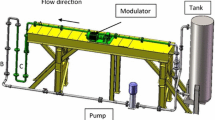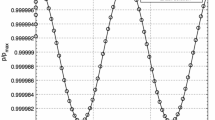Abstract
A new method for deriving accurate thermodynamic properties of gases and vapors (the compression factor and heat capacities) from the speed of sound is recommended. A set of PDEs connecting speed of sound with other thermodynamic properties is solved as a nonlinear least squares problem, using a modified Levenberg–Marquardt algorithm. In supercritical domain, boundary values of compression factor are imposed along two isotherms (one slightly above Tc and another several times Tc) and two isochores (one at zero density and another slightly above ρc). In subcritical domain, the upper isochore is replaced by the saturation line, the lower isotherm is slightly above the triple point, and the upper isotherm is slightly below the critical point. Initial values of compression factor inside the domains are obtained from the boundary values by a cubic spline interpolation with respect to density. All the partial derivation with respect to density and temperature, as well as speed of sound interpolation with respect to pressure, is also conducted by a cubic spline. The method is tested with Ar, CH4 and CO2. The average absolute deviation of compression factor and heat capacities is better than 0.002 % and 0.1 %, respectively.
Similar content being viewed by others
References
M.J. Moran, H.N. Shapiro, Fundamentals of Engineering Thermodynamics (Wiley, Chichester, 2006)
J.P.M. Trusler, Physical Acoustics and Metrology of Fluids (Adam Hilger, Bristol, 1991)
J.P.M. Trusler, M. Zarari, J. Chem. Thermodyn. 24, 973 (1992)
A.F. Estrada-Alexanders, J.P.M. Trusler, M.P. Zarari, Int. J. Thermophys. 16, 663 (1995)
A.F. Estrada-Alexanders, J.P.M. Trusler, Int. J. Thermophys. 17, 1325 (1996)
A.F. Estrada-Alexanders, J.P.M. Trusler, J. Chem. Thermodyn. 29, 991 (1997)
M. Bijedić, N. Neimarlija, Int. J. Thermophys. 28, 268 (2007)
M. Bijedić, N. Neimarlija, J. Iran. Chem. Soc. 5, 286 (2008)
M. Bijedić, N. Neimarlija, Lat. Am. Appl. Res. 43, 393 (2013)
M. Bijedić, S. Begić, J. Thermodyn. 2014, 1 (2014)
A.F. Estrada-Alexanders, D. Justo, J. Chem. Thermodyn. 36, 419 (2004)
C. de Boor, A Practical Guide to Splines (Springer, New York, 1978)
K. Levenberg, Q. Appl. Math. 2, 164 (1944)
D. Marquardt, SIAM J. Appl. Math. 11, 431 (1963)
J.J. Moré, in Numerical Analysis, Lecture Notes in Mathematics, vol. 630, ed. by G.A. Watson (Springer, Berlin, 1978)
V.V. Sychev, The Differential Equations of Thermodynamics (Mir Publishers, Moscow, 1983)
D.Y. Peng, D.B. Robinson, Ind. Eng. Chem. Fundam. 15, 59 (1976)
C. Tegeler, R. Span, W. Wagner, J. Phys. Chem. Ref. Data 28, 779 (1999)
U. Setzmann, W. Wagner, J. Phys. Chem. Ref. Data 20, 1061 (1991)
R. Span, W. Wagner, J. Phys. Chem. Ref. Data 25, 1509 (1996)
J.J. Moré, B.S. Garbow, K.E. Hillstrom, User Guide for MINPACK-1 (Argonne National Laboratory Report ANL-80-74, 1980)
Author information
Authors and Affiliations
Corresponding author
Electronic supplementary material
Below is the link to the electronic supplementary material.
Appendix
Appendix
See Tables 1, 2, 3, 4, 5, 6, 7, 8, 9 and 10.
1.1 Argon in Supercritical Domain
See Figs. 1, 2, 3, 4, 5 and 6.
Relative deviation of Z versus ρ with respect to [18]
Relative deviation of Z versus T with respect to [18]
Relative deviation of cv versus ρ with respect to [18]
Relative deviation of cv versus T with respect to [18]
Relative deviation of cp versus ρ with respect to [18]
Relative deviation of cp versus T with respect to [18]
1.2 Argon in Subcritical Domain
See Figs. 7, 8, 9, 10, 11 and 12.
Relative deviation of Z versus ϕ with respect to [18]
Relative deviation of Z versus T with respect to [18]
Relative deviation of cv versus ϕ with respect to [18]
Relative deviation of cv versus T with respect to [18]
Relative deviation of cp versus ϕ with respect to [18]
Relative deviation of cp versus T with respect to [18]
1.3 Methane in Supercritical Domain
See Figs. 13, 14, 15, 16, 17 and 18.
Relative deviation of Z versus ρ with respect to [19]
Relative deviation of Z versus T with respect to [19]
Relative deviation of cv versus ρ with respect to [19]
Relative deviation of cv versus T with respect to [19]
Relative deviation of cp versus ρ with respect to [19]
Relative deviation of cp versus T with respect to [19]
1.4 Methane in Subcritical Domain
See Figs. 19, 20, 21, 22, 23 and 24.
Relative deviation of Z versus ϕ with respect to [19]
Relative deviation of Z versus T with respect to [19]
Relative deviation of cv versus ϕ with respect to [19]
Relative deviation of cv versus T with respect to [19]
Relative deviation of cp versus ϕ with respect to [19]
Relative deviation of cp versus T with respect to [19]
1.5 Carbon Dioxide in Supercritical Domain
See Figs. 25, 26, 27, 28, 29 and 30.
Relative deviation of Z versus ρ with respect to [20]
Relative deviation of Z versus T with respect to [20]
Relative deviation of cv versus ρ with respect to [20]
Relative deviation of cv versus T with respect to [20]
Relative deviation of cp versus ρ with respect to [20]
Relative deviation of cp versus T with respect to [20]
1.6 Carbon Dioxide in Subcritical Domain
See Figs. 31, 32, 33, 34, 35 and 36.
Relative deviation of Z versus ϕ with respect to [20]
Relative deviation of Z versus T with respect to [20]
Relative deviation of cv versus ϕ with respect to [20]
Relative deviation of cv versus T with respect to [20]
Relative deviation of cp versus ϕ with respect to [20]
Relative deviation of cp versus T with respect to [20]
Rights and permissions
About this article
Cite this article
Bijedić, M., Begić, S. Solution of the Adiabatic Sound Wave Equation as a Nonlinear Least Squares Problem. Int J Thermophys 40, 15 (2019). https://doi.org/10.1007/s10765-018-2479-8
Received:
Accepted:
Published:
DOI: https://doi.org/10.1007/s10765-018-2479-8








































